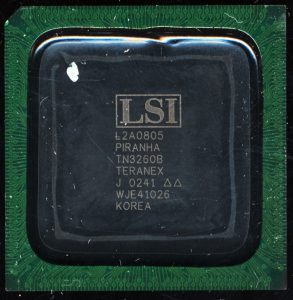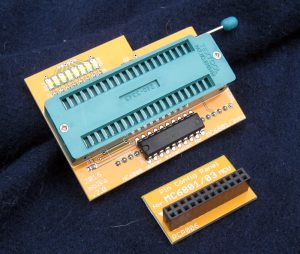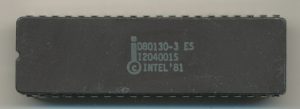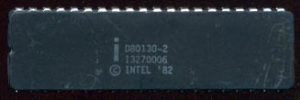March 29th, 2017 ~ by admin

Teranex Piranha TN3260B – 1024 PE Array @ 64-90MHz
The GAPP (Geometric Arithmetic Parallel Processor) was designed in 1981 at Martin Marietta, which later became Lockheed Martin Electronics & Missiles. It was funding in large part by the US Dept. of Defense as a way to develop technologies for ultra high-speed image processing. There was a strong need for image processing, in near real time for military applications, in particular pattern recognition. Being able to process a moving image and match its features to known patterns was very useful for targeting of many weapons system.
The GAPP processor was a massively parallel SIMD (Single Instruction Multiple Data) processor. SIMD works very well on large sets of data that are processed in the same way. In the design of GAPP, this data set was the 2D-array of an image, or frame, from a video. The GAPP is at its core a very large array of simple processors, called processor elements (PE). Each PE is relatively simple, containing a single bit ALU and registers/memory. Each PE handles a single pixel of the image/frame, and is connected in a 2-D mesh to its 4 nearest neighbors. This allows arrays of these PE’s to scale very well. By 1992 Lockheed had GAPP systems with 82,944 elements and by the 2000’s systems were available with nearly 300,000.
In 1998 TeraNex was formed to commercialize this technology, and in 1998 there was a looming problem in television, one that the GAPP, and newly formed TeraNex were well suited to solve.
Read More »
March 15th, 2017 ~ by admin

6801/6803 Expansion Board and PCP
After several months of development an expansion for the 680x/650x Test system is now available to support the very popular and widely used 6801 and 6803 MCUs. The Motorola 6801 was one of the first (with the 6802) MCU’s that Motorola made based on the MC6800 8-bit processor. It includes RAM/ROM, Serial I/O and timers. The test board tests the function of the base CPU, the timers/data capture, and the Serial I/O. The MC6803 is a 6801 without the built-in ROM and with less I/O.
The expansion supports both types as well as their copies/derivatives made by Hitachi, Fujitsu, SGS and others. The expansion is included in the complete 680x/650x Test system, bringing its total supported processors to well over 35. The expansion does require updated firmware, which is included in all new systems (and available to upgrade previously sold systems.)
March 12th, 2017 ~ by admin

Intel D80130-3 OSP – Engineering Sample – Early 1982
A seemingly impossible occurrence today, but something that Intel has faced in the past. It is common for customers to need chips that are no longer in production, either for repair of legacy systems, or to keep an old but reliable design in production. Typically these parts can be sourced on the secondary market, or from End-of-Life suppliers such as REI, or InnovASIC. But what happens when Intel themselves needs a chip that they previously made, but no longer do?
Such was the case with the 80130 Operating System Processor. The 80130 was a co-processor designed in 1981, to make use of Intel’s high-density ROM capabilities. The 80130 contained 16K of ROM, 3 timers (compatible with 8254), an interrupt controller (similar to the 8259), and a baud-rate generator. It was capable of bus management and control and could directly control an 8087 FPU as well. These are designed to work with the 8086/88 and 80186/188 processors. The 16K of ROM was coded with 35 Operating System primitives (a subset actually of the Intel iRMX86 RTOS (Real Time Operating System). This firmware allowed easier support for the constructs typically used in a multitasking OS. Essentially the 80130 extended the instruction set of the x86 to include higher level OS functions.

Intel D80130-2 – 1983 – Production version (though datasheets continued to be marked ‘Preliminary’ though its entire life)
The original version, called (for no known reason) the 80130-3 was released in engineering sample versions only. It could run at up to 8MHz allowing it to work with any of the x86 processors of the time. After some small timing adjustments, the 80130 was released to production as the 80130-2, still keeping with the 8MHz max. Later references show a 80130 at 5MHz as well as the 8MHz -2 part. However, the 5MHz part has not been seen (as of this writing) and is likely to exist only in datasheets.
Read More »





